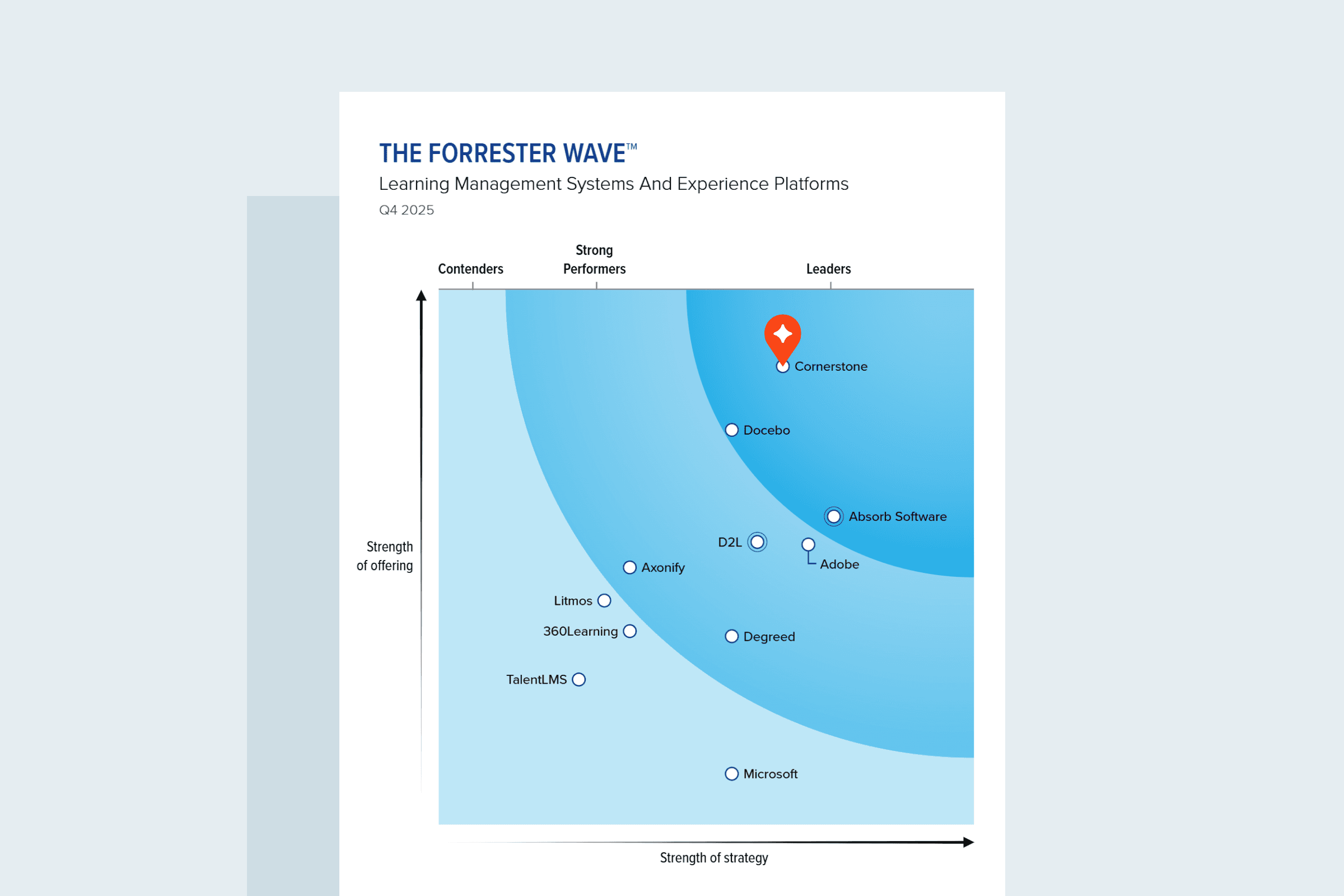Key Takeaways:
- Continuous Training Boosts Retention: Over 70% of employees are likely to stay with organizations offering continuous training, satisfying their hunger for growth and cultivating loyalty.
- Shared Talent Mobility Vision: High-performing companies share a focus on communication, technology, and formal career paths, uniting employees and organisations to drive success.
- Empower Employee Growth: Leveraging AI and skills technology, along with opportunity marketplaces, allows for self-driven career exploration and development, fostering loyalty and longevity.
Re-thinking employee development to fuel your talent mobility
Work today is all about skills and the people who have them. More and more organisations struggle with talent shortages and skills gaps, while the people at these organisations want to stay and are hungry to learn and grow.
In partnership with Lighthouse Research & Advisory, the Cornerstone People Research Lab recently released new research uncovering how organisations can satisfy employees’ hunger for growth. “Ready, set, grow: The building blocks for high-impact talent mobility” revealed more than 70% of employees said they’re more likely to stay with an organisation that offers continuous training and learning.
Mike Bollinger, Global VP of Strategic Initiatives, Cornerstone, takes a closer look at the findings from the 2023 Talent Mobility Study, released by the Cornerstone People Research Lab and Lighthouse Research & Advisory
This talent mobility study gathered data from 1,000 employees and 1,060 employers across EMEA, North America, and Asia. The data can help uncover the meaningful and scalable growth opportunities your employees crave so your organisation can better support their development while filling your talent and skill gaps.
In the study, you’ll find insights that can help you better understand your people's talent experience, including:
- Tactics to improve employee visibility into new roles and opportunities
- Demographics highlighting how different employees want to grow
- Methods for blending managers, culture and technology into a cohesive talent mobility strategy
When organisations need to fill skills gaps yesterday but can’t find people with the right skills, the best place to look is right under their metaphorical noses. Their people want to grow, and they want to grow with them. By investing in talent mobility, organisations can cultivate a culture of career growth, transcend the employee experience and develop short and long-term career paths for their people. Organisations and employees that focus on talent mobility can grow further and faster. But only if they work together.
What is talent mobility and why does it matter?
Talent mobility is the process of transferring an employee from one role to another. In other words, the “four rights.” Talent mobility puts the right people with the right skills in the right place at the right time.
Rather than simply geographic relocation, talent mobility refers to organisations discovering their people’s untapped potential. Organisations supporting and motivating their employees' open opportunities for higher revenue, employee retention, career growth and employee engagement. Talent mobility helps create a vibrant company culture where top talent feels fulfilled and is likely to remain.
Talent mobility only works when we work together. It must be a shared mission between employees and organisations. Our talent mobility study showed that higher-performing companies with higher employee retention rates have three focuses in common:
- A formal communication process and approach
- A technology-enabled strategy
- A formal, established career path
The study found 73% of employees are interested in learning about new company roles. When considering diversity, equity, inclusion and belonging (DEIB), it’s essential to note that women were 50% more likely than men to admit they have little to no visibility into the career opportunities within their company.
Organisations in the EMEA region have taken a manager-centric approach to employee career mobility, putting the responsibility of career growth largely on the shoulders of the worker's direct supervisor, while employees put the primary responsibility on themselves. Learning leaders in EMEA say that the number one way their workforce has visibility into growth opportunities is through manager conversations.
This is important for creating a more equitable workplace because workers who don’t have visibility into internal career growth opportunities are 61% more likely to plan on quitting or finding alternative positions at other companies.
To see more statistics around the critical aspects of talent mobility visit the Cornerstone People Research Lab and Lighthouse Research page here.
Cultivating a culture of career growth
Nurturing a culture of employee career growth is vital to remain competitive.
After surveying 1,000 employees, we found that people who don’t see the potential for advancement in internal opportunities are almost three times more likely to be uninterested in other internal positions within the company. To stay successful, organisations must tightly connect learning initiatives to broader skilling and career growth initiatives.
Organisations can engage their people by empowering them to explore diverse, transparent career growth opportunities. Our research found that:
- High-belonging employees were 190% more likely to say their manager supported them in their personal career growth
- High-performing organisations with better revenue, employee retention and engagement statistics also had a higher ratio of managers and leaders who supported employee growth
- Low-belonging employees are twice as likely to say they wouldn’t consider other career opportunities inside the organisation
Employee belonging intersects with talent development (and manager effectiveness), painting a fascinating picture of how people find meaning in and at work. Career mobility — delivered through a supportive manager and a set of exploratory learning and development tools — can be critical for reconnecting people to their organisations and giving them opportunities to feel genuinely valued. And people who feel connected and valued are the people who stay.
The study revealed that there are a variety of ways that employers can support employee career mobility. In EMEA the top two responses from business leaders focus on personalised learning and visibility into opportunities. Another set of two areas that learning leaders think are quite effective at supporting mobility:
- Formal processes like shadowing and stretch assignments
- A skills dashboard that highlights skills and skill gaps between current and future roles
Leveraging these two options can help to shift the responsibility for career mobility from managers to the workforce, allowing workers to have a greater say in what opportunities they want to pursue.
Organisations cultivating a culture of career growth position themselves to increase performance and thrive in a future-ready workforce.
Transcending the employee experience
Learning and growth silos — where employees only have a narrow view of what they can learn and where they can grow — can hold back even the best people and organizations. Transforming the employee experience away from silos and into more open, transparent opportunities can only be accomplished by organizations. People can grow to fill the gaps they can’t see. By breaking down learning and growth silos, you can ensure that your people have a connected, seamless and holistic talent experience.
Our 2023 talent mobility study found that employee retention improved when employees had available and flexible career paths that included transparency in areas like:
- Skills tracking
- Self-service career mobility exploration
- Accessible learning and skilling opportunities
- Employee development option visibility
Employees who scored low on workplace belonging were six times more likely to say they didn’t know if their employer recognised their skills. In comparison, 90% of workers who quit their job due to the lack of career development opportunities would have stayed if those opportunities were visible and available.
And that’s where the newest “quiet” buzzword comes in. “Quiet hiring” is simply talent mobility. People, who already work at an organization, are switching roles, taking on new responsibilities and learning new skills. Organizations are filling skills gaps and talent shortages using their greatest resource, the people they already have. The “hiring” may be in name only, but there’s nothing quiet about the opportunities they’re opening to their people. The study shows that the primary success metrics for tracking internal career growth in EMEA is simply volume: the number of internal staff moves.
A recent workplace trend in EMEA that is closely connected with career mobility is called “Resenteeism” which is the act of employees showing up to work despite feeling resentful or disengaged. Reduced productivity and performance due to resenteeism can impact an employee's ability to advance in their career. Organizations can take several steps to provide growth opportunities and career mobility to employees:
- Regular performance reviews and feedback
- Professional development programs
- Mentoring and coaching
- Internal job postings
By offering growth opportunities and career mobility to their employees, organisations can not only help employees address resenteeism but also create a more engaged and productive workforce that is better able to achieve organisational goals.
Investing in employee development and talent mobility ensures a more resilient and future-ready workforce that supports higher rates of employee retention and success.
Leveraging AI and skills technology
Short-term and long-term career paths that combine managers, culture and technology into a cohesive talent mobility strategy for your people are vital to success in 2023. Our research found that 73% of employees are interested in learning about new roles and using technology is an effective way to improve visibility into those roles.
Why technological exploration methods instead of simply more conversations around employee development? Technology can make talent mobility opportunities more visible and accessible.
Organizations can make a difference in the short- and long-term by leveraging AI and skills technology to support their people. When workers feel supported — especially in talent mobilsation — they are more likely to report higher levels of workplace belonging and longer-term employment.
Nine out of 10 employees felt supported in their career growth and development if provided with technology to explore career opportunities. One third of organisations in EMEA say their people have visibility into career opportunities through some kind of technology. And workers are 80% more likely to prefer self-service methods of exploring career advancement over direct conversations with managers. With the help of AI-powered technology and databases, you and your organization can achieve higher levels of employee belonging.
Investing in your people with an opportunity marketplace
More than just a collection of career development opportunities, an opportunity marketplace, also known as a talent marketplace, provides self-driven discovery of internal career mobility. These marketplaces have proven to increase levels of company loyalty and longevity.
In the 2023 talent mobility study, we found that employees younger than 45 were 50% more likely than those older than 45 to want to participate in projects that would develop new connections and mentors. You can support your people by opening the door for flexible career paths, not just traditional career ladders.
As shown in the study, employees want opportunities to showcase their skills, get personalized learning experiences, explore options like gigs, special projects, job rotations and job shadowing, and have opportunities for mentor/mentee programs with internal experts. More than half of employees report that having the option to explore various career opportunities within their company made them more likely to stay in their job, with 47% saying they were more satisfied at work.
The top factor in maintaining employee satisfaction and company loyalty with an opportunity marketplace is ensuring that when your people want to explore other internal career development opportunities, they know it won’t jeopardise their current employment. Our research found that “if employees are thinking about leaving their job, their number one value point is exploring new opportunities without risking their current job.”
Having an opportunity marketplace available and transparent to employees is vital for worker retention and longevity.
Finding talent mobility success in 2023
Talent mobility and opportunity marketplaces paint a clear picture that shows they can deliver. As the marketplace landscape continues to transform, employers need a strategic way to attract and retain the right people. Internal career exploration and mobility is a vital way to elevate organisational needs and the career growth desired by your people. Investing in talent mobility opens the opportunity to cultivate career growth, transcend the employee experience and develop short- and long-term career paths for your people. With Cornerstone, you'll find unique, innovative products that help you improve and streamline your talent mobility efforts.
Talent mobility supported with strategic, research-based content is vital to stay ahead of the changing industry. Organizations need to know who is ready to advance to a new role and who needs additional skills to push them to a new position. Talent mobility throughout the platform helps set employees and businesses up for success by giving organizations content for upskilling. Talent leaders have streamed over 27.5 million hours of content on the Cornerstone Content Anytime platform worldwide to support advancing their talent mobility efforts — that is over six times more than other corporate learning platforms. In addition to providing your people with career mobility, an infrastructure to support your talent mobility is essential.
A strategic talent mobility infrastructure is easily managed in one place with a Talent Experience Platform (TXP), which allows you to build resilience and agility through holistic partnerships to scale a talent mobility strategy. Talent mobility is integrated into the systems your people already use, putting learning and growth front and center wherever they are. Cornerstone TXP supports your organization by highlighting and readying your people for career opportunities so that your organization can become a talent magnet — when people get in, they stick.
In today’s changing world, talent shortages are not uncommon. HR leaders must focus on elevating talent mobility to enhance employee learning, growth and retention with transparent and accessible career exploration options to keep organizations growing toward a more secure and successful future.


